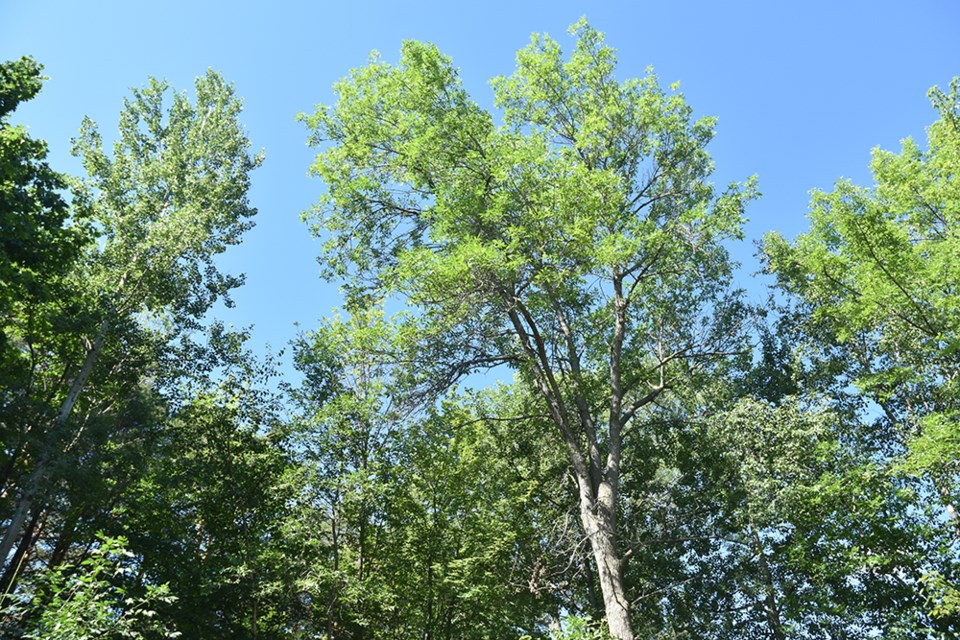Editor's Note: Changes have been made to the original story published on July 15, 2020.
The insect pest Emerald Ash Borer (EAB) has been sweeping across Ontario, killing tens of millions of ash trees and leaving homeowners with the task of taking down their dead and dying trees.
But some homeowners are choosing an alternative: preventative treatment for EAB.
For the past several years, Spring Tree Farms has been offering IMA-JET treatments for the borer, developed by American company Arborjet.
The IMA-JET system uses compressed air to deliver the insecticide Imidacloprid, a neonicitinoid or ‘nicotine-like’ chemical, directly into soft tissue under the bark, through bored holes at the base of the tree.
“It’s injected into the inner two inches of the bark, which is the active sapwood,” said Christina Spring, who was trained to deliver the treatment by her father, Elmer Spring, long-time member of ISA (International Society of Arboriculturalists) and founder of Spring Tree Farm.
It is the tree itself that does the work, the flow of sap delivering the insecticide up the trunk, to every branch.
“It’s a pretty fascinating system,” she said. The insecticide “won’t harm pets or wildlife,” and as for the bore holes, “the trunk will heal itself over a number of years. Trees are magnificent things.”
There are a number of different treatments currently available to fight the borer, but IMA-JET seems to be especially effective. “It has an 85-90 percent success rate, which is why we use it,” she said.
Spring has always loved the Ash tree. “It’s so pretty, and it’s so valuable,” she noted, growing straight and tall, providing cooling shade, wildlife habitat, and valuable wood.
She was heart-broken when a 100’ ash tree on the property she had just purchased had to be removed, due to EAB – which is one reason she got into the field of treatment application.
Treatment can be carried out from May to September, as long as the tree is not in flower – a precaution to prevent the insecticide from impacting pollinator species. Early in spring, the insecticide will prevent the adult borer beetles from laying their eggs; summer treatment kills the larvae that feed under the bark and eventually cause the death of the tree.
“You can start treating any time the sap is flowing,” Spring said, within the parameters set by Agriculture Canada.
Even if there are signs of infestation in an area, there is still time to act, as long as the tree to be treated is healthy. Just don’t wait until a tree shows symptoms of infestation, like crown die-back. “Be pro-active,” said Spring. “Don’t wait for signs of disease.”
The IMA-JET treatment is used for EAB, but also other insect pests, including Asian Long-horned beetle in hardwoods, and Woolly Adelgids in Hemlock.
Spring has been busy, providing IMA-JET treatments “at least one day a week, for the past two months.” She treats approximately 60 ash trees in a season “and that’s growing every year.”
The people who call usually are trying to save a magnificent tree on their property.
“Most people want to do that,” Spring noted, especially since treatment is cheaper than the cost of removing and replacing a full-grown ash tree. Cost is based on the diameter of tree being treated, and the price of the chemicals.
This week, she treated a 19” diameter tree on a property on Park Road in Innisfil. Most of the surrounding ash trees were dead or dying – victims of Emerald Ash Borer – but the towering ash, at least 40 years old, was “a nice, hardy big tree.”
Spring fought her way through poison ivy – “An occupational hazard,” she said – to reach the trunk and deliver a full dose of the insecticide, giving the tree a fighting chance.
Emerald Ash Borer is believed to have been introduced from China, in untreated wood products. The borer and its impact were first identified in 2002, in the area near Windsor. Since then, the insect, which measures 8.5 to about 13.5 mm in length, has spread relentlessly – both flying, carried on wind, and hitchhiking on vehicles and cut wood products.
It attacks all types of ash - green, white, black, blue and red - but not Mountain Ash, which is not a true ash species.
For more information on Spring Tree Farm, and on saving ash trees, click here.
Spring Tree Farm had its roots in the purchase of 16 acres by Elmer and Barb Spring in 1983. The company was incorporated in 1989, and since then has grown to 140 acres, and expanded its range of products and services, winning numerous awards.



